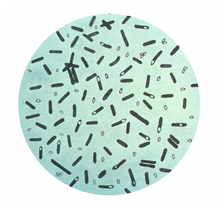
Back مطثية وشيقية Arabic مطثيه وشيقيه ARZ Clostridium botulinum AV Clostridium botulinum Catalan Clostridium botulinum Czech Clostridium botulinum Danish Clostridium botulinum German Κλωστηρίδιο της αλλαντίασης Greek Clostridium botulinum Spanish Clostridium botulinum Estonian
| Clostridium botulinum | |
|---|---|

| |
| Clostridium botulinum stained with gentian violet. | |
| Scientific classification | |
| Domain: | Bacteria |
| Phylum: | Bacillota |
| Class: | Clostridia |
| Order: | Eubacteriales |
| Family: | Clostridiaceae |
| Genus: | Clostridium |
| Species: | C. botulinum
|
| Binomial name | |
| Clostridium botulinum van Ermengem, 1896
| |
Clostridium botulinum is a gram-positive,[1] rod-shaped, anaerobic, spore-forming, motile bacterium with the ability to produce botulinum toxin, which is a neurotoxin.[2][3]
C. botulinum is a diverse group of pathogenic bacteria. Initially, they were grouped together by their ability to produce botulinum toxin and are now known as four distinct groups, C. botulinum groups I–IV. Along with some strains of Clostridium butyricum and Clostridium baratii, these bacteria all produce the toxin.[2]
Botulinum toxin can cause botulism, a severe flaccid paralytic disease in humans and other animals,[3] and is the most potent toxin known to science, natural or synthetic, with a lethal dose of 1.3–2.1 ng/kg in humans.[4][5]
C. botulinum is commonly associated with bulging canned food; bulging, misshapen cans can be due to an internal increase in pressure caused by gas produced by bacteria.[6]
C. botulinum is responsible for foodborne botulism (ingestion of preformed toxin), infant botulism (intestinal infection with toxin-forming C. botulinum), and wound botulism (infection of a wound with C. botulinum). C. botulinum produces heat-resistant endospores that are commonly found in soil and are able to survive under adverse conditions.[2]
- ^ Tiwari A, Nagalli S (2021). "Clostridium Botulinum". StatPearls. Treasure Island (FL): StatPearls Publishing. PMID 31971722. Retrieved 2021-09-23.
- ^ a b c Peck MW (2009). "Biology and genomic analysis of Clostridium botulinum". Advances in Microbial Physiology. 55: 183–265, 320. doi:10.1016/S0065-2911(09)05503-9. ISBN 978-0-12-374790-7. PMID 19573697.
- ^ a b Lindström M, Korkeala H (April 2006). "Laboratory diagnostics of botulism". Clinical Microbiology Reviews. 19 (2): 298–314. doi:10.1128/cmr.19.2.298-314.2006. PMC 1471988. PMID 16614251.
- ^ Košenina S, Masuyer G, Zhang S, Dong M, Stenmark P (June 2019). "Crystal structure of the catalytic domain of the Weissella oryzae botulinum-like toxin". FEBS Letters. 593 (12): 1403–1410. doi:10.1002/1873-3468.13446. PMID 31111466.
- ^ (2010). Chapter 19. Clostridium, Peptostreptococcus, Bacteroides, and Other Anaerobes. In Ryan K.J., Ray C (Eds), Sherris Medical Microbiology, 5th ed. ISBN 978-0-07-160402-4
- ^ Schneider KR, Silverberg R, Chang A, Goodrich Schneider RM (9 January 2015). "Preventing Foodborne Illness: Clostridium botulinum". edis.ifas.ufl.edu. University of Florida IFAS Extension. Retrieved 7 February 2017.